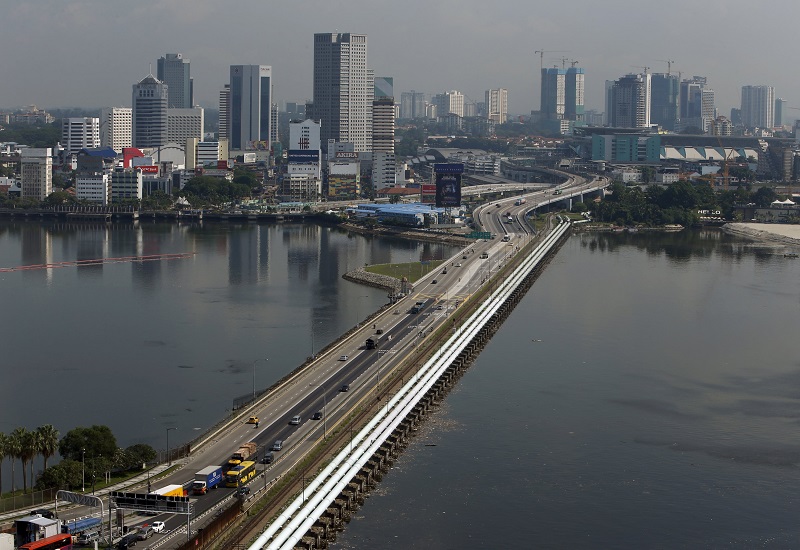KUALA LUMPUR, Oct 31 — After several postponements since the project was first inked in January 2018, Putrajaya is set to announce today that it will finally proceed with the Johor Baru-Singapore Rapid Transit System (RTS).
The deal, which was originally drawn up between the former Barisan Nasional administration and the Singapore government, is crucial not just in terms of connectivity between the neighbouring country and Malaysia’s Southern Economic Corridor Iskandar Malaysia, but is expected to help solve another major issue: long-standing traffic congestion on the Causeway.
Analysts like Socio-Economic Research Centre executive director Lee Heng Guie believe that the areas surrounding the RTS route will likely see a more robust development apart from benefiting from smooth traffic flow.
Making Johor more attractive for Singaporeans
The RTS will specifically service areas surrounding the Southern Economic Corridor Iskandar Malaysia, he said.
“When I went to Iskandar last year, that was what I noticed. How the RTS will cut down the travelling time from Iskandar to Singapore and vice versa.
“If you see the route, it will also raise the value of Iskandar and it will attract Singaporeans to cross over to Johor for a more affordable housing alternative,” said Lee also referring to existing connectivity within the Johor state.
Explaining further, Lee said the government would have made sure that whatever project under it wanted to pursue will yield a multiplying impact.
“On the surface it may look like a lot of money is spent, but time will tell whether it is beneficial to the country.
“For example, if you recall, when projects such as the North South Highway, Kuala Lumpur Twin Towers, the international airport, then, people criticised the rationale behind these projects.
“But now people are beginning to see the value of these projects. Similarly, the RTS could be viewed in this manner,” said Lee when contacted by Malay Mail.
He also expressed confidence that both countries’ governments would have undertaken a lot of studies on the cost and benefit and taken all necessary assessments including the EIA (Environmental Impact Assessment).
“Although the line is for a short distance, but I believe it will spin off a lot of [positive] effects.
“Otherwise, they will go ahead with the project under our current situation,” he said, referring to Putrajaya.
“The Singapore government, they too are will only pursue value for money projects. They would have to take into account the positive spillover, and that they will spend wisely even though they are running on a surplus,” he added.
Most importantly, Lee said the government in whichever project they pursue, it must place priority on addressing the congestion at the Causeway — facilitate mobility, travel congestion and cut down travel time.
“But we should look at this with a positive mindset,” he added.
In May this year, Putrajaya requested a six-month deferment to September which cost RM2 million in abortive costs paid to Singapore.
The Malaysian government also asked for another month of postponement to October 31 with Singapore Ministry of Transport agreeing to waive the compensation or the one-month delay.
The RM4 billion project which was initially proposed to be completed by end-2024 has been deferred six times prior to this latest postponement.
It was reported that should Malaysia choose to opt out, it would have to pay Singapore about RM200 million (S$66 million).
Win-win for both countries
University of Malaya department of business strategy and policy and economist Professor Mohd Nazari Ismail also agreed that the RTS will benefit both countries.
“I think it is a really beneficial project for both Malaysia and Singapore. I don’t see any reason why it should be delayed [anymore],” he said.
Singapore Institute of International Affairs Oh Ei Sun told Malay Mail the RTS would effectively make land along the Johor Baru route “more valuable.”
“Effectively it also makes the Johor Baru plots along its routes more valuable.
“And for a lot of working commuters, it hopefully shortens their travel time,” he said.
Oh added returns may only be evident perhaps only a few years later as people will have to get used to the new commuter lifestyle and realise its potential over time.
“Driving not cheap in Singapore, so it provides an alternative transportion means.
“This will also benefit Singapore as they can now choose to stay in greater Johor Baru,” he added.
But Dr Md Akbal Abdullah from Universiti Tun Hussein Onn feels the RTS could end up as a redundant project since most Malaysians prefer to travel to Singapore with their own vehicles.
“If they take public transport, they would still need to think about how to get around Singapore or to their workplace.
“It could turn into a hassle for Malaysians who travel into Singapore,” he said.
Md Akbal also said the project being announced now could be viewed as a Tanjung Piai by-election “candy”.
“With the by-election around the corner, this may pose as a move to get support from the Tanjung Piai voters since they too go to Singapore,” he said.
Prime Minister Tun Dr Mahathir Mohamad is expected to make the announcement later this afternoon at the Customs, Immigration and Quarantine facility at the Sultan Iskandar Building in Johor Baru.
Transport Minister Anthony Loke Siew Fook is also scheduled to attend the press conference as the RTS Link is directly under his ministry’s portfolio.
The official announcement is highly expected after Dr Mahathir had confirmed that Putrajaya will proceed with the RTS Link during the launch of the National Transport Policy in Kuala Lumpur on October 17.
The announcement should provide specific details on the RTS project as it has been long planned since the early years of Iskandar Malaysia regional economic region, which coincided with former prime minister Tun Abdullah Ahmad Badawi’s tenure.
This follows the Budget 2020 announcement by Finance Minister Lim Guan Eng that the federal government “intends to proceed” with the RTS as a long-term solution to address cross-border congestion.



















